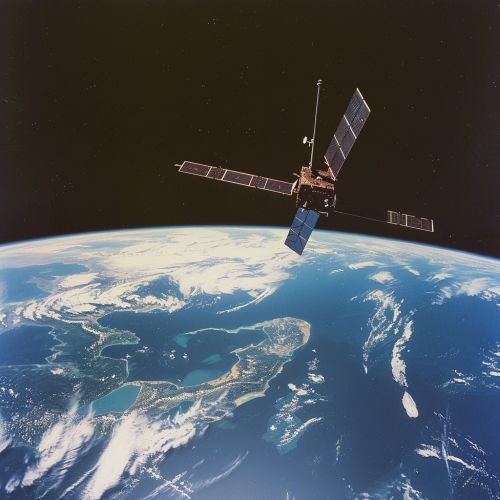Geostationary satellites
Introduction
A Geostationary satellite is a type of earth-orbiting satellite that maintains a constant position relative to the surface of the Earth. This is achieved by orbiting the Earth at the same rotational speed and direction as the Earth itself, resulting in a fixed position in the sky from the perspective of an observer on the ground.
Principles of Operation
Geostationary satellites operate in a specific orbit known as the geostationary orbit, also referred to as the geosynchronous equatorial orbit (GEO). This orbit is directly above the Earth's equator, at an altitude of approximately 35,786 kilometers. At this altitude, the satellite's orbital period matches the Earth's rotational period, allowing the satellite to maintain a stationary position relative to the Earth's surface.


Applications
Geostationary satellites have a wide range of applications, including telecommunications, weather monitoring, and navigation.
Telecommunications
In telecommunications, geostationary satellites are used for satellite TV and radio, internet access, and long-distance telephone services. These satellites can provide coverage over large geographical areas, making them ideal for providing services to remote or rural areas.
Weather Monitoring
In weather monitoring, geostationary satellites are used to monitor weather patterns and atmospheric conditions. These satellites can provide real-time images of the Earth's surface, allowing meteorologists to track storms and predict weather patterns.
In navigation, geostationary satellites are used in systems such as the GPS. These satellites provide precise timing and location information, enabling accurate navigation and positioning.
Design and Construction
The design and construction of geostationary satellites involve several key considerations, including the satellite's mission, its operational environment, and its lifespan.
Mission
The satellite's mission determines its design specifications, including its payload, power requirements, and communication capabilities. For example, a telecommunications satellite may require high-power transponders and large antennas, while a weather monitoring satellite may require sophisticated imaging equipment.
Operational Environment
The operational environment of a geostationary satellite includes factors such as radiation, temperature, and microgravity. These factors can affect the satellite's performance and lifespan, and must be taken into account during the design and construction process.
Lifespan
The lifespan of a geostationary satellite is typically between 10 and 15 years. This is determined by factors such as the satellite's design, its operational environment, and the amount of fuel it carries for station-keeping maneuvers.
Challenges and Limitations
While geostationary satellites offer many advantages, they also face several challenges and limitations. These include the high cost of launch, the limited number of geostationary slots, and the issue of space debris.
Launch Cost
Launching a geostationary satellite is a costly endeavor, involving not only the cost of the satellite itself but also the cost of the launch vehicle and the launch operations.
Geostationary Slots
The number of geostationary slots - the specific positions in the geostationary orbit where satellites can operate without interfering with each other - is limited. This has led to competition and disputes over the allocation of these slots.
Space Debris
Space debris is a growing concern in the geostationary orbit. This debris, which includes defunct satellites and fragments from satellite collisions, poses a threat to operational satellites and can lead to costly damage or mission failure.
Future Developments
Future developments in geostationary satellites may include advances in technology, changes in regulatory frameworks, and new applications.
Technology Advances
Advances in technology may lead to more efficient and capable geostationary satellites. For example, improvements in propulsion systems may extend the lifespan of these satellites, while advances in communication technology may increase their data transmission capabilities.
Regulatory Changes
Changes in regulatory frameworks may affect the allocation of geostationary slots and the management of space debris. These changes could have significant implications for the operation and management of geostationary satellites.
New Applications
New applications for geostationary satellites may emerge as technology advances and new needs arise. These could include new forms of communication, remote sensing, and space exploration.
